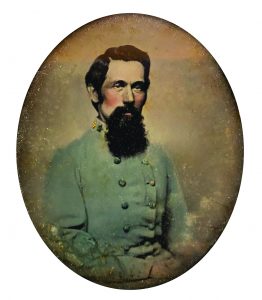
Gen. Gabriel C. Wharton Photo courtesy of Wharton-Radford Papers
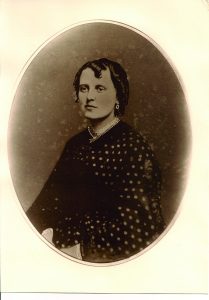
Nannie Radford Wharton Photo courtesy of Radford Heritage Foundation
Back in 1972, an aspiring Civil War historian named William C. ‘Jack’ Davis set out to write a history on the Battle of New Market, Virginia. He reached out to dozens of people via letter, including descendants of key military figures from the battle. Among those was a descendant of Confederate Brigadier General Gabriel C. Wharton. In response, Davis received a cordial but disappointing letter, saying that the family had no documentation of Wharton’s war record in their possession.
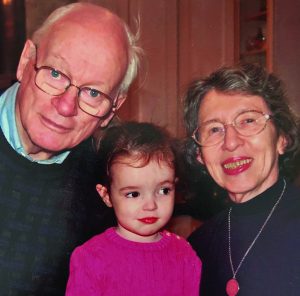
Wharton descendant Sally van Solkema (right) with husband Frits van Solkema (left) with their granddaughter Charlotte (center). Photo courtesy of Wharton-Radford Papers
Some forty years later, however, Wharton descendant, Sue Heth Bell – with no knowledge of the previous exchange – approached Davis about her family’s papers related to the Civil War. During those forty years, the Wharton family had made the very difficult decision to sell Glencoe, a Radford residence that had been in their family for over 100 years. Contained within the home’s attic, they found trunk after trunk full of documents. Wharton descendant Sally, along with her husband, Frits van Solkema, had held onto and carried these trunks with them for decades.

Wharton descendant Sue Heth Bell with some of the family’s treasured documents Photo courtesy Damon Bates Photography
By 2013, the daughter of Sally and Fritz, Sue Heth Bell, had begun investigating the contents of the trunks. It was then that she realized her family had been in possession of a treasure trove of history! Within the confines of those long-sealed trunks were thousands of letters, documents, and journals spanning from the 1840s to the early 1900s. Through the writings of her ancestors, Bell discovered she had some amazing documentation of what life was like in Southwest Virginia during the Civil War.
Forty years ago, Jack Davis thought he had encountered a dead end for his writing project about the Battle of New Market. Today, however, in partnership with Sue Bell, Davis is bringing to light one of the most complete accounts of the Civil War – relating specifically to Southwest Virginia – to survive the war itself.
At the outbreak of the Civil War, Gabriel C. Wharton found himself, like many others, at a great precipice as the nation faced possible dissolution. As a native Virginian, Wharton enlisted in the Confederate war effort and soon found himself stationed in the far southwestern portion of Virginia, a region containing vast supplies of mineral deposits, such as salt, lead, and iron. Despite the region’s great importance and the bounty of raw materials it held for the war effort, Wharton was forever frustrated by his appointment. There was one thing the region had, however, that brought him his greatest happiness.
Anne “Nannie” Radford was coming of age in Southwest Virginia at the outset of the Civil War. A child of privilege, Nannie was the eldest daughter of John Blair and Elizabeth Taylor Radford – a name that would later be placed upon the City of Radford. Nannie was a fiery young woman, never one to shy away from letting her thoughts and feelings be known.
By February 1863, Wharton and Nannie were engaged. To say the very least, Wharton was besotted, but it would take some time for the more pragmatic Nannie to voice her love. They began a correspondence that carried from their engagement to marriage, and even into the first years of wedded life. Theirs was life forever at the mercy of the times and events that surrounded them.
Wharton, who was quite the romantic, asked his wife to save all the letters and sew them together. Upon completing the task, Nannie wrote her husband saying, “I have just finished the peculiar task of arranging our letters in a volume. They make a very ponderous one.”
Unfortunately, Nannie only lived until 1890, passing away at age forty-six. Her husband survived her by sixteen years, passing in 1906 at the age of eighty-one. With Wharton’s passing, thus ended a chapter of history, and a lifetime of memories were sealed away.
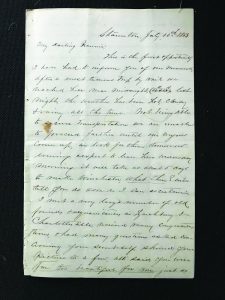
Letter from Gen. Wharton to Nannie Radford Wharton Photo courtesy of Wharton-Radford Papers
All told, there are 524 surviving letters between Wharton and Nannie, spanning from 1863 to 1865. This set of correspondence is nearly a complete dialogue between two people as they entered marriage while facing a war in a changing world. They not only cover large scale events, but also the problems that we would now describe as ‘personal issues’. These letters offer a completely unfiltered view into the couple’s relationship, which at times defies conventional wisdom about gender dynamics.
From the moment she knew she would marry the then Colonel Wharton, Nannie pushed for him to move up the military ranks. From their letters, it was apparent that both understood that Wharton was to become nothing short of a Major General. Unfortunately, he only managed the rank of Brigadier General. He’d become frustrated in the effort whenever confronted with politics, or ‘wire-pulling’, as he called it. He faced having the realize that it was not always by merit alone that one advanced.
His wife, however, was the encouraging force he needed, writing such lines as, “And you will not have yourself promoted. Doubtless in my heart I secretly admire that delicacy & nobility of character wh[ich] prompts you to act so, but alas, it so materially interferes with the ruling passion of my life – Ambition – that I am almost tempted to condemn it & quarrel with you in good fashion.”
The Whartons’ letters provide countless insights into their world, including the lives of their enslaved workers. At the time of their marriage, Wharton and Nannie received an enslaved couple, Tim and Emeline Lewis, from her parents. Tim became Wharton’s body servant on the battlefront and the two developed a close relationship. Emeline remained with Nannie at home in what is now Radford. The complexities of southern slave culture are apparent from the Whartons’ compassionate inquiries into the wellbeing of Tim and Emeline while living with the understanding that these people were their property. A fascinating development to see in the letters is when Tim began to assert his independence as he shed the name Tim (his name in slavery) and took on the name William, the name he carried for the rest of his life.
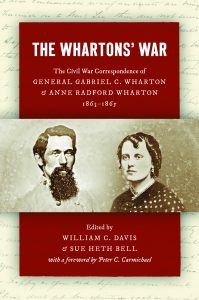 Information like this and much more is found in the Whartons’ letters, and it shows there is so much more to learn about the history of the region. They will be made available this summer, 2022, in the publication “The Whartons’ War: The Civil War Correspondence of General Gabriel C. Wharton and Anne Radford Wharton”, published by the University of North Carolina Press.
Information like this and much more is found in the Whartons’ letters, and it shows there is so much more to learn about the history of the region. They will be made available this summer, 2022, in the publication “The Whartons’ War: The Civil War Correspondence of General Gabriel C. Wharton and Anne Radford Wharton”, published by the University of North Carolina Press.
Glencoe Mansion, Museum & Gallery
600 Unruh Drive, Radford, VA • www.glencoemansion.org
Scott Gardner, Executive Director
540-731-5031 • info@glencoemansion.org
